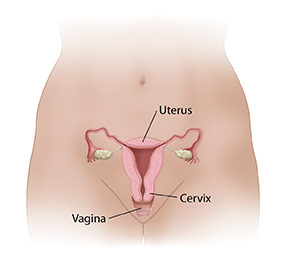What Is Cervical Cancer?
What is Cervical Cancer?
Cancer occurs when cells in the body change and grow out of control. These cells can form lumps called tumors. Cancer that starts in cells of the cervix is called cervical cancer. The cervix is the lower end of the uterus. It connects the uterus to the vagina.
Cervical cancer can spread from the cervix to other parts of the body. This spread is called metastasis. The more cancer spreads, the harder it is to treat.
Types of cervical cancer
When cells in the cervix begin to grow in ways that are not normal, it is called dysplasia. Dysplasia is not cancer, but it can lead to cancer if not treated. Once cancer forms, there are 3 possible types:
Squamous cell carcinoma. This starts in the thin, flat cells on the surface of the cervix. This is by far the most common form of cervical cancer.
Adenocarcinoma. This starts in gland cells of the cervix.
Mixed carcinomaor adenosquamous carcinoma. This is cancer in both types of cells.
What causes cervical cancer?
In most women, cervical cancer is caused by the human papillomavirus (HPV). HPV infection is very common and often goes away on its own. But in some cases, over time, HPV may lead to cervical cancer. HPV infection is strongly linked to cervical cancer. But it's important to know that most women with HPV don’t develop cervical cancer.
Other risk factors include:
Smoking
Other lifestyle factors such as diet and activity
Being overweight
Long-term use of birth control pills (oral contraceptives)
Having chlamydia or herpes (sexually transmitted diseases)
Having a weak immune system
Having multiple full-term pregnancies
Having a full-term pregnancy before age 17
Having a family history of cervical cancer
Talk with your healthcare provider about your own risk for cervical cancer.
Can cervical cancer be prevented?
Get routine Pap tests. Regular testing with a Pap test, with or without an HPV test, can help find cervical cell changes before they become cancer. Treating these changes can keep cancer from starting. Cervical cancer grows slowly. So regular testing can also help find this cancer early--when it's small and easier to treat.
Get vaccinated. HPV vaccine can protect against certain types of HPV infection. The vaccine only works if given before an infection with HPV. So it should be given before a person becomes sexually active. It's available for girls and boys ages 9 to 14 to be vaccinated using a 2-dose schedule. If the vaccine is given from ages 15 to 26, a 3-dose schedule should be used. It is a preventive vaccine. It is not effective for people who have already been exposed to HPV. No vaccine gives full protection against all cancer-causing types of HPV. It’s still important to get routine Pap and HPV tests.
Don't smoke. Smoking has been linked to cervical precancer and cancer. Women who smoke are about twice as likely as nonsmokers to get cervical cancer. Tobacco smoke contains many cancer-causing chemicals that are carried throughout the body in the blood. These chemicals have been found in the cervical mucus of women who smoke.
Use condoms. Condoms need to be used correctly and every time you have sex. But condoms don't offer total protection against HPV infection. That’s because the HPV virus can still be spread through skin-to-skin contact with any infected part of the body. This includes the skin in the genital area that can’t be covered by a condom. Condoms can provide some protection as well as help protect against other sexually transmitted diseases.
Talk with your healthcare provider about the cervical cancer screening schedule that's best for you. Also talk about how to prevent cervical cancer.
What are the symptoms of cervical cancer?
In early stages of cervical cancer, most women will not have any symptoms. As the tumor grows or the cancer spreads, the most common symptoms are:
Abnormal vaginal bleeding
Vaginal discharge
Pain during or bleeding after sex
These symptoms may seem like other conditions, including infection. See your healthcare provider if you have any of these symptoms. Ask how often you need a Pap test.
How is cervical cancer diagnosed?
Cervical cancer is usually found during a screening Pap test. During a Pap test, cells are taken from a woman’s cervix and checked for changes that may signal dysplasia or cancer. This can help catch cervical cancer early, when it is easiest to treat. Have a Pap test as often as your healthcare provider suggests.
How is cervical cancer treated?
You and your healthcare provider will discuss a treatment plan that’s best for your needs. Treatment options may include:
Surgery. The part of the cervix with cancer may be removed. Or the entire cervix and the uterus may be removed (total hysterectomy).
Radiation therapy. This uses directed rays of energy to kill cancer cells.
Chemotherapy. This uses strong medicine to kill cancer cells. It may be used along with radiation therapy.
Targeted therapy. This uses medicines (not chemotherapy medicines) that are designed to attack and kill cancer cells and limit the damage to healthy cells.
Updated:
June 05, 2018
Reviewed By:
Goodman, Howard, MD,Stump-Sutliff, Kim, RN, MSN, AOCNS,Cunningham, Louise, RN,Image reviewed by StayWell medical illustration team.
